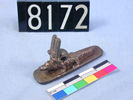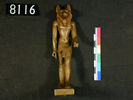
Gods and goddesses in Ancient Egypt:
the main names at the main places
Ancient Egyptian writings and personal names indicate that the main god or goddess at the nearest large town would be a central part of religious life for the individual. A list of workers from different towns, on a papyrus dated about 1800 BC, shows that already then many people named their children after the 'god of the city' (Hayes 1955). So, if you lived near Koptos, a town north of Thebes in Upper Egypt, you might well have been named after the local main god Min, with a name like Minhotep 'Min is content'.
The religious map of Egypt changed over time. The cult of Amun, restricted to Thebes in the Middle Kingdom (about 2025-1700 BC), was installed at several other sites in the first millennium BC. Similarly, the cult of Isis was not prominent in temples before the fourth century BC, when vast new temple structures were planned at Philae on the southern border beyond Elephantine, and at Behbeit el-Hagar near Samanud in the central Delta: the great goddess of the early temples is Hathor.
The following list introduces all the gods and goddesses who were worshipped as the main divine force in the principal towns of Egypt (compare the list of provinces of Egypt, including reference to surviving temple structures). You may not have come across some of these names before, because the deities of less well-preserved places have tended to be overlooked in books about Ancient Egypt. In one long listing, covering dozens of ancient cities, the number may look daunting. Here we have broken the list into two parts:
This list is not a guide to the principal deities of Egypt, but to the names and forms given at local level to the principal divine force in that area. Other gods are prominent in other contexts, such as creation. Some gods and goddesses appear in the different contexts, but it should be remembered that geographical presence is only one aspect of divinity.
In the list the abbreviations LE, UE plus number refer to Lower Egypt and Upper Egypt province or 'nome' in the Ancient Egyptian standard sequence
Part One: Main temple gods and goddesses in several places
goddess of sensual power. Main deity at the temples of Gebelein (UE4), Denderah (UE6), Qusiya (UE14), Atfih (UE22), and with prominent separate temples at the key cities of Memphis (LE1) and Iunu/Heliopolis (LE13). A fused form Hathor-Sekhmet was the principal deity at Imu/Kom el-Hisn (LE3).
 |
sistrum with a Hathor head (click on the image for a larger picture) |
god of kingship, celestial power. Main deity at the temples of Edfu (UE2), Nekhen/Hierakonpolis (UE3), Qus (UE5), Hebenu (unlocated city of UE16). In Lower Egypt Horus is main deity at Tjaru/Sile (LE14) as 'Horus of Mesen', and he was equated with or absorbed the originally separate gods Khentykhem at Khem/Ausim (LE2) and Khentykhety at Athribis in the Delta (LE10). Horus was the joint main deity of several other cities where the other main deity was a potentially anarchic or destructive force, as if he was needed to balance and contain their potentially negative presence: with Sobek at Kom Ombo (UE1), and Medinet el-Fayum (UE22); and with Seth in the province of Shashotep (UE11). Perhaps for similar reasons, in the province of the Seth-like god Nemty he formed a composite god Horus-Dunanwy at Sharuna (UE18).
 |
Horus falcon (click on the image for a larger picture) |  |
image of Horus on a stela (click on the image for a larger picture) |
god responsible for making the forms of beings in creation. Main deity at the temples of Elephantine (UE1), Esna (UE3), Herwer (unlocated city of UE16), Shenakhen/Tarkhan (UE21). He is also prominent on stelae set up in the temple at Mendes (LE16).
 |
ram headed god, maybe Khnum (click on the image for a larger picture) |
ferryman god, with an ambivalent character in myth similar to the anarchic Seth (open to bribery), and shown in formal art exactly like Seth. Main deity at the temples of Qau (UE10), Atawla (UE12), province of Sharuna (UE18)
god of disruptive power. Main deity at the temple of Naqada (UE5), and perhaps, under the name Igay 'sceptre-god', in the province of Permedjed/Oxyrhynchus (UE19); balanced by Horus in the province of Shashotep (UE11).
god of the violent power embodied in crocodiles. Main deity at the temple of Imiotru (destroyed site near Rizeiqat, UE4), and with Horus at Kom Ombo (UE1) and Medinet el-Fayum (UE22), and with Amun at one temple in Tadehnet/Tehna (UE16).
 |
crocodile god (click on the image for a larger picture) |
Part Two: gods and goddesses prioritised in only one or two places
god protecting women and children at birth (his name means 'Fighter'). Main deity in the Middle Kingdom at Khemenu/Ashmunein (UE15) - later named Bes and widespread as childbirth protector but not as a principal temple god
 |
Bes figure, found at Amarna (click on the image for a larger picture) |
god of universal power (his name means 'the hidden one'). Main deity in Middle Kingdom only at Thebes (UE4), in New Kingdom (about 1550-1069 BC) at other sites, and in first millennium BC in vast new temple complexes at Balamun (LE17) and Tanis (LE19); with Sobek at a temple in Tadehnet.Tehna (UE16)
 |
detail of stela with the figure of Amun (click on the image for a larger picture) |  |
bronze statue, probably representing Amun (click on the image for a larger picture) |
god of young kingly power and of embalming. Main deity with the god Bata in the region of UE9
 |
seal, with inscription: 'Anubis, who is in the embalming (click on the image for a larger picture) |  |
jackal headed god. bronze statue (click on the image for a larger picture) |
goddess associated with the qualities of desert gazelles, and so perhaps with hunting. Worshipped mainly in Elephantine province (UE1)
quadruple god incorporating the 'ba' or divine power of the first four generations of creation - Ra, Shu, Geb and Osiris. Main deity at Djedet/Mendes (LE16)
goddess of the protective power of ointment. Main deity at Bast/Bubastis (LE18)
 |
bronze statue of a cat (or lion) headed goddess, maybe Bast (click on the image for a larger picture) |
goddess absorbed into the character of Hathor in the Middle Kingdom. Main deity in the region of UE7, perhaps also originally at Dendera (UE6)
herdsman (?) god. Main deity with the god Anubis in the region of UE9
god absorbed by the god of the dead Osiris, originally perhaps separate as main deity of Busiris (LE9)
god of uncertain character. Main deity at the temple of Ihnasya (UE20)
 |
tomb relief showing Heryshef (click on the picture for more information) |
god of restorative power (the name means 'he who brings back the distant goddess' - restoring the eye of the sun-god). Main deity at the temples of Thinis (unlocated city in UE8) and in the fused form Inheret-Shu at Tjebennetjer/Samanud (LE12)
god incorporating the kings of preceding generations, absorbed into the god of the dead Osiris by the Middle Kingdom. Main deity at the temple of Abydos (UE8) and Akhmim (UE9)
god presumably of leonine majesty and power (his name means 'wild lion'). Main deity at Taremu/Tell el-Moqdam (LE11)
god of male procreative power. Main deity at the temples of Koptos (UE5) and Akhmim (UE9)
 |
stela, showing Min and Horus behind him; from Koptos (click on the image for a larger picture) |
god of aggressive power. Main deity originally at three cities in the province of Thebes (UE4): Tod, Medamud, Armant
goddess sometimes of androgynous character with warrior qualities, sometimes associated with the primeval waters from which creation emerged. Main deity at the temple of Sais (LE5), and with Khnum at Esna (UE3) and Sobek in the Fayum (UE22)
 |
 |
bronze figures of a goddess with a red crown, showing perhaps Neit (click on the images for a larger picture) |
god of the dead. Main deity at the temple of Semenuhor in the area of Tarkhan (UE21); he absorbed Khentyamentiu to become main deity at Abydos (UE8), and absorbed Heqaandjet to become main deity at Busiris (LE9)
| stela with the depiction of a woman in front of Osiris (click on the image for a larger picture) |
god of material creation, crafts. Main deity at Memphis (LE1)
 |
naos with the figure of Ptah in it, found at Memphis (click on the image for a larger picture) |  |
ostracon with a picture of Ptah (click on the image for a larger picture) |
sun-god, principal creator in Ancient Egyptian religion. Main deity at Khasu/Xois (LE6) and in the double form Ra-Atum at Iunu/Heliopolis (LE13); as Atum 'the undivided all' at the beginning of creation, main deity at Kheraha (LE13) and Per-Atum/Pithom, Ramesside city at Tell el-Retaba, moved in Late Period to Tell el-Maskhuta (LE8)
goddess perhaps associated with the rising waters of the annual Nile flood. Main deity at a temple on Elephantine (UE1)
goddess of avenging fury. Main deity with the god Ptah at Memphis (LE1), and in the fused form Hathor-Sekhmet at Imu/Kom el-Hisn (LE3)
 |
lion-headed goddess, may Sekhmet (click on the image for a larger picture) |
god of knowledge and writing. Main deity at the temples of Khemenu/Ashmunein (UE15) and Baqliya (LE15)
 |
faience figure of a god with an Ibis head (found at the palace of Apries in Memphis) (click on the image for a larger picture) |  |
votive stela showing Thoth as baboon (click on the image for a larger picture) |
Copyright © 2002 University College London. All rights reserved.